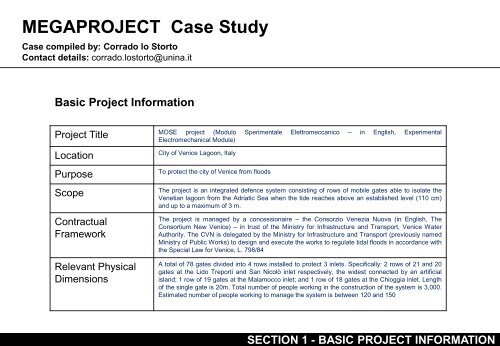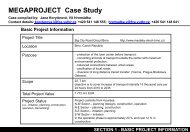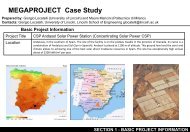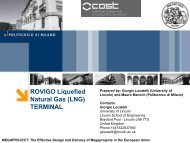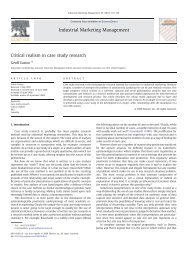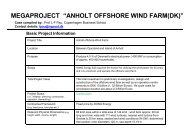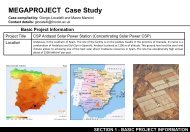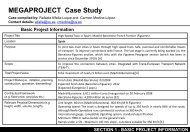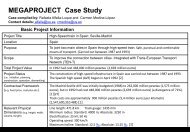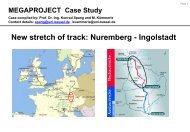MEGAPROJECT Case Study
MEGAPROJECT Case Study
MEGAPROJECT Case Study
- No tags were found...
You also want an ePaper? Increase the reach of your titles
YUMPU automatically turns print PDFs into web optimized ePapers that Google loves.
<strong>MEGAPROJECT</strong> <strong>Case</strong> <strong>Study</strong>SECTION 1 - BASIC PROJECT INFORMATION
<strong>MEGAPROJECT</strong> <strong>Case</strong> <strong>Study</strong>SECTION 1 - BASIC PROJECT INFORMATION
SECTION 2 - PROJECT STAKEHOLDERS<strong>MEGAPROJECT</strong> Stakeholder Identification (Internal) 1Stakeholder Category <strong>Case</strong>-<strong>Study</strong> Comments (e.g. maturity,previous experiences ofstakeholders, skills, influence onproject)Supply-Side Client Consorzio Venezia Nuova (CVN) Equity joint venture Consortiumspecifically formed for this project.CVN is responsible for studying,monitoring, planning,experimenting and implementingmeasures delegated to the Stateto safeguard Venice and thelagoon on behalf of the Ministryfor Infrastructure and Transport inaccordance with the Special Lawfor Venice (Law n. 798/84)FinanciersPublic funds from Italian Government , European Investment Bank, and European CommissionSponsorsn/aClient’s Customers The Italian Government through the Ministry for Infrastructure and Transport – the Venice Water Authority The Venice Water Authority is thelocal department of the Ministryfor Infrastructure and Transportwith direct and primaryresponsibility for the safeguard,security and hydraulic protectionof a large area falling within anumber of North Italy regions(Veneto, Friuli and Trentino AltoAdige)Client’s Owners At the start of the project: Impregilo (39.4%), Consorzio Italvenezia (Società italiana per Condotte d’acqua, Astaldiand Mantelli) (18.5%), Grandi Lavori Fincosit-Mazzi (18.5%), San Marco – Consorzio Costruttori Veneti (Co.Ed.Mar,Cantieri Costruzioni Cemento, Grassetto Lavori, Impresa di Costruzioni Ing. E. Mantovani, Intercantieri Vittadello,Sacaim, Cir, Consorzio Rialto, Consorzio Lepanto) (13.875%), Consorzio Veneto Cooperativo (2.775%), Saipem (2.5%),Società italiana per Condotte d’acqua (2.5%), Società Consortile Venezia Lavori (Impresa di Costruzioni Ing. E.Other internal supplysidecategories (pleasespecify)Mantovani) (1.85%), Consorzio Grandi Restauri Veneziani (0.1%)Category<strong>Case</strong>-<strong>Study</strong>Public Research InstitutionThe CNR (National Research Council) in 1980 launched apublic contest to collect ideas for Venice safeguard
SECTION 2 - PROJECT STAKEHOLDERS<strong>MEGAPROJECT</strong> Stakeholder Identification (Internal) 2Demand Side(this case has a largenumber of main andsub-contractors.Here a sample ofthem is reported)StakeholderCategoryPrincipalContractors<strong>Case</strong>-<strong>Study</strong>Thetis SpA was in charge of the study and research activity in the marine engineering field in the concept stage ofthe projectCordioli Costruzioni Metalliche SpA was selected through a public tender to manufacture the first 23 retractingoscillating buoyancy flap gates and the metallic caissons to be placed in the Lido-Treporti inlet. Each caisson has thefollowing dimensions: weight 300 tons, height 20m, thickness 3.60m.Comments (e.g. maturity,previous experiences ofstakeholders, skills, influenceon project)This company was acquired by theConsorzio Venezia Nuova fewyears ago. According to a recentdecision of the Consorzio VeneziaNuova Board, Thetis will changeits mission , focusing only on theMOSE facilities maintenanceFirst TierContractorsNuovi Cantieri di Chioggia SpAConsorzio Maccaferri per il Progetto Venezia (Maccaferri Venice Project Consortium) – Adanti SpA, OfficineMaccaferri Group and Sarti SpA. The consortium has developed a system for the production of a Ballasted FilterMattress (BFM), a filter layer that would guarantee the hydraulic performance required, heavy enough to keep thefilter in contact with the sea bed at all times and in all sea conditions.FIP SpA was selected to design and manufacture the special large hinges to rotate gates. The company took out apatent for the design of this model of hinge. The total number of hinges assembled in the MOSE is156. The hinge isconsidered a critical component of the system and the Committee “No MOSE” required major assurances related toreliability of this component.Società Consortile MOSE Treporti (construction), Ing. E. Mantovani (second tier, construction), Trentin Consulting srl(first tier, professional services), etc.ProfessionalServices ProvidersOther internalsupply-sidecategories (pleasespecify)Joint venture C. Lotti & Associati SpA and Thetis SpAPRINCIPIA was entrusted by the Municipality of Venice the task to test the reliability and the feasibility of thehinge.Category<strong>Case</strong>-<strong>Study</strong>This joint venture is responsiblefor: a) works managegement, b)support and control for worksrealization, material qualitycontrol, c) works costmanagement
SECTION 2 - PROJECT STAKEHOLDERSPublic<strong>MEGAPROJECT</strong> Stakeholder Identification (External) 1StakeholderCategoryRegulatoryAgenciesLocalGovernment<strong>Case</strong>-<strong>Study</strong>ISPRA (Istituto Superiore per la Protezione e la Ricerca Ambientale) was identified as an independent institution (according tothe European Commission note # 13085, 15.07.2008). In particular, ISPRA validates and control the environmental monitoringactivities, evaluate environmental data released, check if environmental targets are met.European Commission. In April 1999, the European Parliament issued the Resolution on the crisis situation in Venice. Calling onthe Italian Government to decide by the end of the year on proceeding to the final design phase of the project. In December2005, after the claim of some environmental movements, the European Commission started the infringement procedurerelative to the lagoon habitat pollution, because the EC Environmental DG retained that the Italian Government had notplanned effective mitigation measures to preserve wild birds migration and habitat. In 2008, the Venice Water Authorityinformed the EC Environment DG about the mitigation measures adopted, thus making available financial resources from theEuropean Investment Banking (circa 750,000 euro)TAR (Tribunale Amministrativo Regionale) and Consiglio di Stato. In total 9 legal petitions have been lodged with the TAR andConsiglio di Stato, all related to environmental issues. All claims have been rejected.Local Authority of Venice (Municipality of Venice)Local Authority of Chioggia (Municipality of Chioggia)Regione Veneto (Regional Administration of Veneto).The Provincial Authority of VeniceComments (e.g. maturity, previous experiences of stakeholders, skills,influence on project)The EC was favourable to project.Favourable to project. Decision made on July 14, 2000 was particularlyimportant. On the grounds of breaches of procedure and substance, theRegional Administrative Tribunal for the Veneto (TAR) issued a rulingannulling the Dec. 1998 decree of negative environmental impact of theMinistry of the Environment . The appeals against the decree had beenmade by the Veneto Region, ASCOM and fish farming companies. TAR alsorejected all the appeals made against the MOSE system by a number ofbodies including WWF, Italia Nostra, and Provincial Authorities. On Dec. 20,2004 the Sixth Division of the Judicial State Council (Consiglio di Stato) hasturned down all the appeals filed by the Province, WWF and Italia Nostraagainst the Veneto Regional Tribunal sentence of May 22, 2004.Favourable to project., but some concern about the construction of thefacilities. On Feb 22, 1999 the Venice Local Authority expressed its opinionon the design, passing an extremely complex resolution inviting the Mayorto call for “…the continuation of design work at the lagoon inlets”. Thathappened after the judgment of negative environmental compatibility ofthe design expressed by the Ministry of the Environment EIA Commission.The operations necessary to the construction of the prefabricated concretecaissons that will be implanted on the reinforced seabed are presumed tobe detrimental to the construction site (the Pellestrina inlet)Favourable to project. On Feb. 3, 1999, in a specific vote, the Chioggia LocalAuthority expressed its opinion, considering it “indispensable for thedefence process to continue in its entirety […] including defence againstexceptional high waters” and delegating the Mayor to call for “…thecontinuation of design work at the lagoon inlets”Favourable to project. On Sept. 18, 1998 the full Veneto Regional TechnicalCommission approved the design
SECTION 2 - PROJECT STAKEHOLDERS<strong>MEGAPROJECT</strong> Stakeholder Identification (External) 2StakeholderCategory<strong>Case</strong>-<strong>Study</strong>Comments (e.g. maturity, previous experiences of stakeholders, skills,influence on project)PublicNationalGovernmentThe Ministry of the Environment Not favourable to the project design when it was released. On Dec. 10,1998 the Ministry of Environment EIA Commission expressed a negativeopinion as regards the environmental compatibility of the design. Thus, onDec. 24, 1998 the Ministry of the Environment together with the Ministry ofCultural Heritage expressed “…as the situation stands at present, ajudgement of negative environmental compatibility “, adding, however,that “the design could be reviewed…”The Ministry of the Cultural HeritageThe Ministry of Public Works/The Ministry of Infrastructure and Transport was the promoter of the MOSE project.Favourable to project. On Dec. 10, 1998 the Ministry of Cultural HeritageCentral Office for the Environment and Landscape expressed a positiveopinion as regards the design for mobile barriers, with certain provisions.Otherinternalsupply-sidecategories(pleasespecify)The Committee for Policy, Coordination and Control (the so called “Comitatone”) of all measures for the safeguard of Venice.It is the body for policy, coordination and control of the objectives established by the special legislation (see Art. 4 of Law no.798/84). This Committee was made up of representatives of the competent authorities and institutions (Ministries ofInfrastructure and Transport, Environment and Territorial Protection, Cultural Heritage and Activities, University Education andScientific Research), the Chairman of the Water Authority, the Chairman of the Veneto Regional Authority, the mayors ofVenice and Chioggia and Treporti-Cavallino Local Authority and two representatives of the other local authorities along thelagoon boundary). It is chaired by the President of the Council of Ministers. The secretary of the Committee is the President ofthe Venice Water Authority.Category<strong>Case</strong>-studyUniversity and research institutionsCORILA (Consorzio di Istituti Universitari e Enti diricerca). The Consortium was entrusted tomonitor environmental impacts of constructionoperations in the constructoin siteIndependent experts Commission of international experts. Toproduce the Environmental Impact Assessmentof the design for mobile barriers, the waterAuthority and its concessionary called on thecollaboration of, among others, a panel ofprofessors from the Massachusetts Institute ofTechnology. This panel of experts followed theprogress of studies and validated the results.
SECTION 3 - PROJECT MANAGEMENT<strong>MEGAPROJECT</strong> Project ManagementProject OrganisationClient Project Team Size &StructureContractor Project Team Sizeand StructureSub-Contractor Project TeamInvolvementMajor role of Consorzio Venezia Nuova in the project management. CVN is a private body, a concessionaryentrusted with the task of coordination activities (feasibility study, EIS, executive design, public procurement,works management monitoring, etc.), that acts for the public interest. It interfaces the granting Administrationand the executors of the safeguard measures (designers, consultant for special studies and experimentation,companies carrying out works). CVN consists of large private Italian companies, consortia, cooperatives, andlocal firms.CVN was delegated by the Ministry of Public Works to design and execute the works to regulate tidal floods onthe basis of Law no. 798/84 (Agreement no. 6479/85).Project Tools and TechniquesPlease √ if present, x if absent , leave blank if unknownLife-Cycle Costing Approaches □Stakeholder Involvement □Building Information Modelling (BIM) □Project Management Software □Relationship Management Tools □Project Knowledge Management Tools □Lessons Learnt Transfers □Team Building Tools □Competency framework □Other Tools and Techniques or More InformationThe collection of special laws and decrees (> 26) that have been issued by the Italian Parliament and by the Veneto Regional Administration provided the operational and fundingframework that enabled the progress of project.Art. 4 of Law no. 798 of Nov. 29, 1984 set up the Committee for Policy, Coordination and Control of all measures for the safeguard of Venice, the so-called “Comitatone”, made up ofrepresentatives of the competent local and national authorities and institutions (Ministries of Infrastructure and Transport, Environment and Territorial Protection, Cultural Heritage andActivities, University Education and Scientific Research, the Chairman of the Water Authority, the Chairman of the Veneto Regional Authority, the mayors of Venice and Chioggia andTreporti-Cavallino Local Authority and two representatives of the other local authorities along the lagoon boundary) and chaired by the President of the Council of Ministers. Thesecretary of the Committee is the President of the Venice Water Authority. The Comitatone is the body for policy, coordination and control of the objectives established by the speciallegislation issued for Venice and the lagoon.The control system also included crossed audits and verifications implemented at different levels by a number of bodies: a) the High Council of Public Works (Ministry for Infrastructureand Transport), the Venice Water Authority Technical Committee (The Venice Water Authority), the Venice Water Authority Panel of Experts (The Venice Water Authority SafeguardingDept.), and the Consorzio Venezia Nuova. The Ministry of Environment, the Ministry of Cultural Heritage and the Veneto Regional Administration have a role in the EIS implementation.Programme Agreements are also an important operational tool that was introduced by Law no. 139/92 into safeguarding procedures. In the case of strictly interconnected measuresinvolving a number of different authorities and institutions, the programme agreement enabled the identification of a joint action plan, integrating the measures to be carried out by thesingle different bodies and, if necessary, appointing a single implementing body. Irrespective of the implementing body, responsibility for achieving the individual objectives remains withthe legally responsible institution. It is assumed that coordinated and unitary implementation of the various measures within a programme agreement might improve operationalefficiency, optimise implementation times, reduce costs and mitigate social costs. Thirteen agreements have been signed.According to Art. 3 of Law 139/92, funds to implement works aimed at regulating tidal floods may be assigned after the audit and verification of an acceptable progress of otherinterventions (measures aimed at slowing down degradation of the morphological structures caused by subsidence, eustatism and erosion resulting from wave motion and wash, etc.) bythe Comitatone.
SECTION 3 - PROJECT MANAGEMENTProject ProcessesRisk Management ProcessesPresent (describe below) X Not Present □ No Information □•Detailed and extensive investigation to identify effective solutions to solve the problem of high water•Implementation of agreements among several bodies to improve coordination and procedural efficiency•Involvement of international, independent experts to implement and validate EIS resultsHR Management ProcessesProcurement ManagementProcessesIntegration ManagementProcessesScope Management ProcessesTime Management ProcessesCost Management ProcessesQuality management ProcessesCommunications ManagementProcessesPresent (describe below) □Not Present □ No Information XPresent (describe below) □Not Present □ No Information □Public tenderPresent (describe below) □Not Present □ No Information XPresent (describe below) □Not Present □ No Information XPresent (describe below) □Not Present □ No Information XPresent (describe below) □Not Present □ No Information XPresent (describe below) □Not Present □ No Information XPresent (describe below) □Not Present □ No Information X
<strong>MEGAPROJECT</strong> Project PerformanceAspects of Performance Concerned with Doing the Project RightOriginal Targets and changes to targetsPerformance relatingto time - the conceptualisation and the study in search for feasible solutions that lead to the project began in 1975- executive design approved and start of the works and the construction site in 2003- completion of works estimated at the end of 2010Actual Achievements Against Targets- estimated completion of works at the end of 2015 (completion time was 2012 in2008)- test of the gates placed in the Treporti inlet in 2013Performance relatingto costPerformance relatedto specification-planned cost of 2,3 billion €-planned annual operating cost from 5 million € to 9 million €- no. 4 mobile barriers being constructed at the lagoon inlets (2 at the Lido inlet, 1 at Malamocco and 1 atChioggia)- no. 78 the total number of gates- no. 1 lock for large shipping at the Malamocco inlet enabling port activities to continue when the gatesare in operation- no. 3 small locks (2 at Chioggia and 1 at Lido-Treporti) to allow the transit of fishing boats and othersmaller vessels when the gates are in operation- 3 m the maximum tide which the gates can withstand- 60 cm the increase in sea level the MOSE System has been designed to cope with- 9,850 m of rock-fill to complete the visible structures such as the small craft harbours, jetty reinforcementand breakwaters- 4,590 m of vertical wall required to complete the visible structure such as locks and “abutments” for therow of gates- 597,000 squared metres of bed protection and underwater structures required for completion- estimated cost to complete 4,678 billion € (5,5 billion according to not officialestimations)- estimated annual operating cost from 12 million € to 18 million € (30 million €according to not official estimations) (including maintenance)- no. 0 gates completed and placed- 63% of the work already completed- 3,000 people currently directly or indirectly employed- 9,000 m of rock-fill already completed- 4,100 m of vertical wall already completed- 398,700 square metres of bed protection and underwater structures alreadycompletedAspects of Performance Concerned with Doing the Right ProjectStakeholder Original Aims of Project Involvement and Changes to these Aims Achievement of these AimsUNESCO, EC To preserve cultural heritage in Venice and natural habitat in the Venice lagoon As the project has not yet been completed and infrastructure isnot operating, the stakeholder aim s are not achievedNational and localGovernmentsTo safeguard Venice, i.e. to guarantee the complete defence of all built-up areas in the lagoon from high waters of alllevels, including extreme events, the arrest and reversal of deterioration processes of the lagoon basin, in the same timeguaranteeing port activity, water quality, and the safeguarding of lagoon morphologyAs the project has not yet been completed and infrastructure isnot operating, the stakeholder aim s are not achievedVenice residents, tourists,shopkeepersTo solve the problem of high waters that has afflicted Venice and other towns and villages in the lagoon since ancienttimesAs the project has not yet been completed and infrastructure isnot operating, the stakeholder aim s are not achievedSECTION 4 - PROJECT PERFORMANCE
SECTION 5 - PROJECT ENVIRONMENT<strong>MEGAPROJECT</strong> Project EnvironmentLegal and Regulatory EnvironmentLegal and RegulatoryProject Environment(regionally, nationally andEurope wide)The legal and regulatory framework that is not strictly related to the project is:- Law 349/86: Introduction of the Ministry of Environment and norms related to the environmental damage . This law introduced the procedure to carry on the environmentalimpact study and the list of infrastructure works needing EIS- Law 443/2001 – Legge Obiettivo: Delegation to the Government for strategic infrastructure and productive settlements and other interventions for the re-launching ofproductive activitiesSpecific Legal andRegulatory events impactingon the projectMajor legislative milestones:- Law 171/73: “The safeguarding of Venice and its lagoon is a matter of pre-eminent national interest”- Law 404/75: Protocol for publishing the international call for tender-competition for preservation of the hydrogeological equilibrium in the Venice lagoon and the reduction ofhigh waters in historic centres- Vote no. 209 of 1982: Positive judgement by the Higher Council of Public Works to General feasibility Plan (the so called “Progettone”) covering all the measures necessary to“preserve the hydrogeological balance of the lagoon and mitigate high waters in the historic city and town centers”- Law 798/84: Identification of a single body which takes responsibility for all activities (studies, experimentation, plans, and activities) associated with physical defence andrestoration of environmental balance. This law represents the legal basis for the delegation of these activities to the Consorzio Venezia Nuova through private negotiationsexempted from normal procedures- Convention no. 6479/85: on the basis of Law 798/84, CVN is delegated by Ministry of Public Works to design and execute the works to regulate tidal floods- Ministry of Cultural Heritage, Decree of August 1, 1985: Declaration of considerable public interest concerning the ecosystem of the Venice lagoon situated in the localauthority areas of Venice, Jesolo, Musile di Piave, Quarto d’Altino, Mira, Campagna Lupia, Chioggia and Codevigo- Regional Law – Veneto Region 27/1990: Regulations for the execution of the responsibilities assigned to the Region by Law 798/84(this is only a selection of laws, decrees, and decree laws)Economic EnvironmentEconomic Project EnvironmentSpecific Economic Events impacting on the projectLate 2000 recessions and scarcity of funds.None identifiedPolitical EnvironmentPolitical Project EnvironmentSpecific Political Events impacting on the projectThe last conservative government had a particular interest for the realization of large infrastructure investments.Any change occurred in the political government alliances and structure, both at the national and local level.
TIME198419821966197319751981SECTION 6 - PROJECT TIMELINETECHNICAL FEASIBILITY ANALYSIS & ALTERNATIVE EVALUATIONDESIGN & PROCUREMENT<strong>MEGAPROJECT</strong> Project Key Events and Activities TimelineEVENTS IN THE PROJECTEVENTS IN THE ENVIRONMENTNovember 4. Catastrophic sea storm measuring 194 cm onthe Punta della Salute tide gauge. Venice and other townsand villages in the lagoon are completely submerged undera meter of water. Incalculable damage. There is a clearawareness that the survival of the city will never again becertain unless action is taken to defend it.The Special Law n. 171 declares the problem of Venice tobe "of priority national interest" and identifies thephysical unity and continuity of the lagoon.International competition-call for tender issued by the Ministry of Public Works for the design and construction ofhigh water defences. Five groups of companies take part. The tender is not awarded, but five projects are used as abasis to draw up the so-called "Progettone".The "Progettone", the first feasibility study and preliminary design to protect Venice from high water, is drawn upand presented.The "Progettone" is approved, with specific requirements, by the Higher Council of Public Works.Law No 798 of 29 November redefines the general objectives of the measures for the safeguarding of Venice. Art. 4sets up the Committee for Policy, Coordination and Control of all measures, the so-called "Comitatone", made upof representatives of the competent local and national authorities and institutions and chaired by the President ofthe Council of Ministers.
1995199419931992DESIGN & PROCUREMENT19901989TIME<strong>MEGAPROJECT</strong> Project Key Events and Activities TimelineEVENTS IN THE PROJECTEVENTS IN THE ENVIRONMENTNovember 17. The new conceptual design of the mobile barriers at the lagoon inlets to protect Venice from highwater is presented and then approved as part of a general plan of interventions to safeguard Venice.The conceptual design of mobile is approved by the Higher Council of Public Works.July. The preliminary design for the mobile barriers at the lagoon inlets is completed.November. The preliminary design for the mobile barriers at the lagoon inlets is approved by the Water AuthorityTechnical Committee, a branch of the Higher Council of Public Works.A Committee of Experts from leading international engineering companies appointed by Consorzio Venezia Nuova,the Concessionary of the Venice Water Authority, give a positive opinion on the preliminary design.October 18. The preliminary design is approved by the Higher Council of Public Works.July 4. The Committee for Policy, Coordination and Control (the "Comitatone"), considering the requests of Venice Local Authority, passa resolution calling for the preliminary design for the mobile barriers to be submitted to an Environmental Impact Assessment (EIA),delegating the Water Authority (as the body proposing the plan) the task of producing an Environmental Impact <strong>Study</strong> (EIS) andestablishing a schedule. But the uniqueness of the Venice case also led to the adoption of an "extraordinary" EIA procedure. TheCommittee, in fact, decided to flank the Ministry of the Environment EIA Commission by a Panel of international experts. Members ofthe Panel are: Prof. Philippe Bourdeau (coordinator) IGEAT Université Libre de Bruxelles, Bruxelles, Belgio; Prof. Jean-Marie Martin,Environment Institute, Joint Research Centre, European Commission Ispra, Italia ; Prof. Chang C. Mei, Massachusetts Institute ofTechnology, Cambridge, MA, USA; Prof. Ignazio Musu, Facoltà di Economia, Università di Ca’ Foscari, Venezia, Italia; Prof. Pier Vellinga,Institute for Environmental Studies, Vrije Universiteit, Amsterdam, Olanda.SECTION 6 - PROJECT TIMELINE
TIME2001199819992000SECTION 6 - PROJECT TIMELINEDESIGN & PROCUREMENT<strong>MEGAPROJECT</strong> Project Key Events and Activities TimelineEVENTS IN THE PROJECTEVENTS IN THE ENVIRONMENTJuly 7. The Panel of international experts consign its Report to the President of the Council of Ministers, the Minister of Public Works andthe Minister of the Environment. In its conclusions, the document states that the project is effective, does not cause large scale impactsand has minimal and mitigable influence on the local scale. It also states that "the system of mobile barriers" integrated with localdefences, "responds adequately to current problems, while leaving options for the future open". At the end of the Report, theCommission of experts indicated a number of specific provisions and additions.July 21. The commission of five international experts expresses a favourable opinion.September 18. The Veneto Region Technical Commission expresses a favourable opinion on the design.December 10. The Directorate General of the Ministry of Culture expresses a favourable opinion with certain reserves. On the same daythe Ministry of the Environment Environmental Impact Assessment Commission expresses a negative opinion on the design.December 24. The Minister of the Environment together with the Minister of the Cultural Heritage, considering the position of theMinistry of the Environment EIA Commission, expressed, "as the situation stands at present, a judgment of negative environmentalcompatibility", adding, however, that "the design could be reviewed..."February 3. In a specific Vote, the Chioggia Local Authority expresses its opinion, considering it "indispensable for the defence process tocontinue in its entirety [...] including defence against exceptional high waters" and delegating the Mayor to call for "...the continuationof design work at the lagoon inlets".February. The Venice Local Authority expresses its opinion on the design, inviting the Mayor to call for "the continuation of design workfor mobile barriers at the lagoon Inlets".February 26. A general meeting of the Higher Council of Public Works expressed its opinion on the EIS of the mobile barriers,unanimously reconfirming its favourable opinion on the design solution.March 8. The Committee for Policy, Coordination and Control (Comitatone) considered the various opinions expressed during theextraordinary EIA of the design for mobile barriers at the lagoon inlets. In a Resolution, the Committee unanimously delegated theWater Authority to undertake directly when responsible, or to coordinate with others when needed a series of interrelated in-depthstudies to be completed by December 31.July 12. The Committee for Policy, Coordination and Control (Comitatone) considers the results of the development work carried out and,in light of differences of opinion between the Ministry of Public Works and the Ministry of the Environment, refers the decision regardingcontinuation of design work to the Council of Ministers.July 14. On the grounds of breaches of procedure and substance, the Regional Administrative Tribunal for the Veneto (TAR) issued a rulingannulling the December 1998 decree of negative environmental impact of the Minister of the Environment in agreement with theMinister of the Cultural Heritage.March 15. Meeting at Palazzo Chigi, in Rome, the Council of Ministers concludes the EIA procedure. Its Resolution calls for work to beginon the definitive final design of the mobile high water protection barriers at the inlets. Specific provisions and additions are alsorequired, as the "dissipative capacity of the lagoon inlets channels to be increased".December 6. The Committee for Policy, Coordination and Control (Comitatone) expresses the opinion that design of the Mose systemshould go ahead and that at the same time "measures aimed at increasing the dissipative capacity of the lagoon inlet channels should bedeveloped".
TIME2003200420022001SECTION 6 - PROJECT TIMELINEDESIGN & PROCUREMENT<strong>MEGAPROJECT</strong> Project Key Events and Activities TimelineEVENTS IN THE PROJECTEVENTS IN THE ENVIRONMENTDecember 18. The Venice Water Authority instructs its concessionary, the Consorzio Venezia Nuova, to draw up a plan of activitiesresulting from the Comitatone resolution of 6 December 2001.February 22. The programme is presented and approved by the Water Authority Technical Committee, a branch of the Higher Council ofPublic Works.September 30. The Consorzio Venezia Nuova consigns the final design for the whole Mose system, with adaptation of the design formobile barriers and introduction of the complementary structures and and the navigation lock at the Malamocco inlet.November 4. The Environmental Impact Assessment Commission of the Veneto Region approves the design for the complementarybreakwaters at the Malamocco and Chioggia inlets and the design for the navigation lock at the Malamocco inlet; the design for thebreakwater at the Lido inlet will be re-examined after being reviewed on the basis of given observations.November 8. The final design of the Mose system is approved by the Water Authority Technical Committee, a branch of the HigherCouncil of Public Works.November 29. The CIPE (Interministerial Committee for Economic Programming) finances the first tranche of the Mose system amountingto € 450 million.February 25. Meeting in Rome, the Comitatone postpones conclusion of the decision-making process until the 3 April meeting, allowingthe local authorities of Venice and Chioggia more time to present their opinions on the final design for the Mose system.April 3. A unanimous resolution of the Comitatone give the go-ahead to executive design work and construction of the Mose system, atthe same time taking on board specific requests from Venice and Chioggia Local Authorities. These requests do not, in fact, interfere withthe structure of the system as defined in the final design and do not therefore represent a constraint to its implementation.April 15. The Water Authority Technical Committee approves the final design for the complementary breakwater at the Chioggia inlet.June 6. The Water Authority Technical Committee approves the "Plan of studies, designs and measures following the decisions takenduring the 3 April 2003 session of the Committee as per Art. 4 of Law no. 798/84".October 17. The Water Authority Technical Committee, a branch of the Higher Council of Public Works, approves setting up of a series oftrial areas at the Lido inlet to verify the operational systems designed to consolidate the seabed near the rows of gates.January 20. The Safeguarding Commission expresses a favourable opinion on the final project of the Mose system.January 30. The Water Authority Technical Committee, a branch of the Higher Council of Public Works, approves the design for: theconstruction of the refuge haven at Lido – Treporti; the reinforcement of the Lido south jetty; the construction of the navigation lock atthe Malamocco inlet and the refuge haven at the Chioggia inlet.February 13. The Plan Office is set up. Setting up of the Office was agreed on 6 December 2001 by the Comitatone. The tasks of the PlanOffice is to harmonise the plans of the individual authorities (State, Regional, Local) responsible for the safeguarding activities andoptimise the resources.
TIME20052004SECTION 6 - PROJECT TIMELINEDESIGN & PROCUREMENT<strong>MEGAPROJECT</strong> Project Key Events and Activities TimelineEVENTS IN THE PROJECTEVENTS IN THE ENVIRONMENTFebruary 27. The final design for the work to construct the navigation lock at the Chioggia inlet is approved by the Water AuthorityTechnical Committee, a branch of the Higher Council of Public Works.May 22. The Veneto Regional Tribunal rejects all the appeals made against the Mose system by a number of bodies including theWWF, Italia Nostra and Venice Local and Provincial Authorities.June 7. The provincial secretaries of the Italian trade unions C.G.I.L., C.I.S.L. and U.I.L. and the Consorzio Venezia Nuova sign aFramework Agreement covering work already underway or planned for the near future as part of construction of the mobile barriers atthe inlets.June 22. The final design for the first phase of the protection of the sea bed along the San Nicolò channel, at the Lido inlet, is approvedby the Water Authority Technical Committee, a branch of the Higher Council of Public Works.July 19. The final design for the first phase of the works for the reinforcement of the Forte San Pietro area, at the Malamocco inlet, isapproved by the Water Authority Technical Committee, a branch of the Higher Council of Public Works.September 29. The CIPE (Interministerial Committee for Economic Programming) finances the second tranche of the Mose systemamounting to € 709 million.November 4. The Committee for Policy, Coordination and Control meets in Rome. The agenda includes the progress of work, inparticular on the Mose system, the "eleven points" requested by Venice Local Authority and the one point requested by Chioggia LocalAuthority. Transfer of a contribution for Venice, Chioggia and Cavallino Treporti local authorities from funds financed by the CIPE(Interministerial Committee for Economic Programming) (arts. 80 L. 289/2002 and 23-quater D.L. 355/2003 conv. L. 47/2004).December 20. The Sixth Division of the Judicial State Council has turned down all the appeals filed by the Province, Venice LocalAuthority and a number of associations including the WWF and Italia Nostra against the Mose system and the Veneto RegionalTribunal sentence of 22 May 2004.January 28. the Regional Environmental Impact Assessment concluded with a favourable opinion on the environmental compatibility ofthe project to set up sites at the Malamocco and Chioggia inlets to prefabricate the caissons for the mobile gates and abutments.April 29. In accordance with the Framework Agreement between the provincial secretaries of the Italian trade unions C.G.I.L., C.I.S.L. andU.I.L. and the Consorzio Venezia Nuova signed in 2004, a round table is set up with the participation of representatives of the tradeunions and the consortium and procedures are established for communicating between the individual groups of companies operating atthe three lagoon inlets. The parties jointly agree to meet with the local authorities to discuss the matter of accommodating theworkforce employed in construction of the barriers.May 20. The final design for the preparation of two new parallel cable pipelines across the inlet channel at the Chioggia inlet, isapproved by the Water Authority Technical Committee, a branch of the Higher Council of Public Works. The cable pipelines are beingconstructed using the remote controlled horizontal boring technique.
TIME20062005SECTION 6 - PROJECT TIMELINE<strong>MEGAPROJECT</strong> Project Key Events and Activities TimelineEVENTS IN THE PROJECTEVENTS IN THE ENVIRONMENTJune 20. The Minister of Infrastructure and Transport, Pietro Lunardi, visited the work sites where construction of the tidal regulationbarriers at the lagoon inlets is underway. The Minister, together with the President of the Veneto Region Giancarlo Galan, Deputy Mayorof Venice Michele Vianello and President of the Venice Water Authority Maria Giovanna Piva inspected the work sites at the Lido,Malamocco and Chioggia inlets. He then went to the Arsenale where he met representatives of local institutions and visited the dry docksin the historic dockyards of the Serenissima. During the meeting, the President of the Venice Water Authority put forward a proposal toset aside part of the north area of the Venice Arsenale for management and maintenance of the Mose system.July 21. The Water Authority Technical Committee approves the final design for the following projects: at the Lido inlet, designs forpreparation of the work site at the south San Nicolò abutment (construction of wharfs for vessels to come alongside, a logistics area insupport of site activities and a temporary platform for storing materials, etc) and the second phase of work to construct the intermediateisland between the rows of gates (creation of a navigational channel to the rear of the island to connect San Nicolò and Treporti when theinlets are closed and filling of the nucleus of the island with dredged material); at the Malamocco inlet, designs for the navigation lock(civil engineering work for the door housing structures on the sea and lagoon sides and for the guide structures) and preparation of thework site at the north abutment (construction of a temporary platform for storing and selecting materials, wharfs for vessels to comealongside, a logistics area in support of site activities, etc); at the Chioggia inlet, designs for construction of the north abutment (civilengineering for the wharf and hard standing linking the barrier abutment and lock embankments) and construction of the lagoon sidebasin of the refuge haven (construction of the breakwater on the channel side of the harbour, the inner bank of the north side of theharbour, dredging of the inner basin, etc).September 28. A meeting of the Committee for Policy, Coordination and Control took place in Rome. The Commitee coordinates theactivities to safeguard Venice and its lagoon. The Committee, chaired by the President of the Council of Ministers Silvio Berlusconi,decided to continue the realization of the Mose system. The progress of the requests expressed by the Municipalities of Venice andChioggia (11 points) has been verified, and the technical controls will be considered by the Plan Office. Furthermore, the financing ofcontributions to the State, Region and Municipalities has been requested.CONSTRUCTION & OPERATION 17March 29. The CIPE (Interministerial Committee for Economic Programming) finances the third installment of the Mose system to regulatetidal floods amounting to 380 million euro.July 20. A meeting of the Committee Coordination and Control (Comitatone) for the safeguarding of Venice and the lagoon, chaired by thePresident of the Council of Ministers Romano Prodi, took place in Rome.The Comitatone decided to enlarge the composition of the Committee to the Province of Venice and the Municipality of Cavallino-Treporti. Besides, it confirmed the commitment to carry on the financing of the Mose system by the Cipe, and, at the same time, to reestablishthe financing of the Special Law for the other safeguarding measures. The possibility of transfer 50 million euro from 380deliberated by the Cipe on March 20, 2006, to the others measures foreseen in the Special Law, has been discussed.With regard to the Mose system, the Committee decided to verify the proposals that the Municipality of Venice will arrive at thePresidency of the Council of Ministers before July 31, 2006. The DICA (the Administration of the Presidency of the Council of MinistersDepartment) will prepare the proceedings for the next meeting of the Committee. Until that date, the realization of work at the lagooninlets, will follow the foreseen programming.
TIME2006200720082010SECTION 6 - PROJECT TIMELINE<strong>MEGAPROJECT</strong> Project Key Events and Activities TimelineEVENTS IN THE PROJECTEVENTS IN THE ENVIRONMENTNovember 10. The Council of Ministers approves, by a majority of votes, the report on the Mose system drawn up by the Minister forInfrastructure Antonio Di Pietro.November 22. A meeting of the Committe of Coordination and Control for the safeguarding of Venice and the lagoon, chaired by thePresident of the Council of Ministers Romano Prodi, took place in Rome. With regard to the defence of Venice from the high water(Mose), which is under realization since 2003, the Committee decided to complete the Mose system work and the morphologicalmeasures connected, giving assurance of financing, and complying with engagement and programme defined by the agreement betweenthe State and the concessionary Consorzio Venezia Nuova.August 3. The CIPE (Interministerial Commitee for Economic Programming) financed 243 million of euro for the Mose work.January 31. The CIPE (Interministerial Commitee for Economic Programming) financed 400 million of euro for the Mose work.December 18. The CIPE (Interministerial Commitee for Economic Programming) approved the financing of 800 million of euro.CONSTRUCTION & OPERATION 17November 18. The CIPE (Interministerial Commitee for Economic Programming) approved the financing of 230 million of euro.
• 1-http://www.consorziovenezianuova.com/corporate.htm• 2-http://mediateca.consorziovenezianuova.com/• 3-http://www.magisacque.it/ilmav.htm• 4-http://www.salve.it/banchedati/Documenti/uk/Accordi.htm• 5-http://www.salve.it/banchedati/Leggi/uk/decreti%20legge.htm• 6-http://www.salve.it/banchedati/Leggi/uk/leggi.htm• 7-http://www.salve.it/banchedati/Letteratura/uk/Risultati.asp• 8-http://www.salve.it/uk/soggetti/soggetti.htm• 9-http://www.salve.it/uk/soluzioni/acque/mose_avanzamento.htm• 10-http://www.salve.it/uk/soluzioni/acque/mose_studi.htm• 11-N. Doni and R. Signorelli, “Le Tecniche di Project management applicate al progetto Venezia”, available in http://www.salve.it/banchedati/Letteratura/uk/Risultati.asp• 12-M. Gentilomo and G. Cecconi, “Flood protection system designed for Venice”, available in http://www.salve.it/banchedati/Letteratura/uk/Risultati.asp• 13- P.A. Moro, “Profilo del Consorzio Venezia Nuova”, available in http://www.salve.it/banchedati/Letteratura/uk/Risultati.asp• 14- http://www.marinadiliogrando.eu/mose_sistem.html• 15- http://www.salvemose.it/?area=2&menu=3&page=53• 16- http://www.calcolostrutture.net/il-mose.html• 17- Lucia Vergano, Georg Umgiesser and Paulo A.L.D. Nunes, “An Economic Assessment of the Impacts of the MOSE Barriers on Venice Port Activities”, Fondazione Eni EnricoMattei and Ca' Foscari University of Venice, 2010, http://www.bepress.com/feem/paper407• 18-”CASE HISTORY: MO.S.E. PROJECT, VENICE, ITALY”, Ref: UK-IT/CH/EP027 — Rev:01, July 08, available in www.maccaferri.co.uk• 19-http://www2.comune.venezia.it/mose-doc-prg/• 20-A. Vitucci, “La visita nei cantieri del Mose: cassoni alti come grattacieli”, April 2011, available in http://nuovavenezia.gelocal.it/cronaca/2011/04/29/news/la-visita-neicantieri-del-mose• 21-http://www.drytech.ch/new/svbreferenzegenio06.php?lang=en• 22-G. Dallaporta, “Il MOSE: un progetto che nasce dal CNR”, http://www.fi.cnr.it/r&f/n12/dallaporta.htm• 23-http://www.ilvelino.it/articolo.php?idArticolo=1434671• 24-http://www.italiamiga.com.br/noticias/artigos/prima_pietra_per_il_mose.htm• 25-http://www.maccaferri.co.uk/PAGES00648.html• 26-E. Della Frattina, “Mose, l’eterno incompiuto che costa molto e serve a poco”, http://www.patrimoniosos.it/rsol.php?op=getarticle&id=85118• 27-http://www.cooperativasanmartino.it/pagina.aspx?ID=2101• 28-http://www.edilportale.com/news/2003/04/aziende/mose-impregilo-in-consorzio-venezia-nuova_3738_5.html• 29-Consorzio Venezia Nuova and Magistrato alle Acque, “Nuovi interventi per la salvaguardia di Venezia: studio di impatto ambientale, sintesi non tecnica”, 2004.


